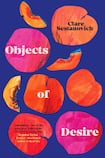
“A writer with enviable success, a kind of fame that seemed to befit a different profession: people knew his name and his face, they got sentences from his books tattooed in visible places.” In one of 11 engaging stories in Clare Sestanovich’s Objects of Desire, a young woman attending a reading of a famous writer muses on his atypical celebrity. It is a perspective on the writing world that rings true, fittingly featured in a debut collection that tells the kind of subtle, graceful stories that often get overlooked.
There are no shocking plot twists or hypersardonic voices in Objects of Desire, just an astute chronicling of ordinary life that results in sharp and sometimes surprising tales of people in crisis or undergoing change. They are quiet dramas, rich with unique detail and moments of recognition. In shape and tone, there are echoes of writers such as Elizabeth Strout and Alice Munro, though the storylines have a more contemporary feel.
Sestanovich lives in Brooklyn and is an editor at the New Yorker. Her fiction has been published in the New Yorker, the Paris Review, Harper’s and Electric Lit. Many of the stories take place in a brightly rendered New York: impossible rent prices, the culture of double-jobbing, trendy Brooklyn or the wealthier neighbourhoods where “all the apartment buildings have names and all the dogs have haircuts”.
Thematically, the author focuses on relationship break-ups and new starts. Her characters range from early 20s to mid-life, people struggling with identity, longing for life to begin or to begin again.
In the opening story, Annunciation, a college student flying home shares the joy of a new baby with a couple who’ve done a pregnancy test on the plane. As life is happening all around her, the narrator tries to find her place in the world. Her more sophisticated friend Charlotte acts as an adviser: “There was nothing, she said, as powerful as eating masculine foods with feminine grace.”
In By Design, a female graphic designer has a mid-life crisis with terrible repercussions, even as her stoner husband thrives in middle-age: “He went running barefoot and called recipes ‘projects’. He made curry powder with a mortar and pestle.”
Difficult friends
Terms of Agreement gives a great window into the world of aspiring writers, but also that of difficult friends and the demands they can make of others: “For months, every time we saw her – we kept seeing her, we kept worrying about her – the first thing she did was tell us about her latest change.”
The triangular relationship at the centre of this piece is repeated elsewhere in the collection. The title story sees its narrator, Leonora, get closure on an ex, which is to say closure on her past, to focus more on her relationship with her current boyfriend. Security Questions has shades of Raven Leilani’s Luster – an open marriage of a middle-aged couple where the man dates a younger woman.
In Old Hope, the narrator talks to her friend Max about his sexual problems with his girlfriend Hannah. The lines between friend and lover blur, resolutions come and go. This is a trait of many of the stories, whose endings are often abrupt and leave the reader with plenty to think about. Occasionally, it feels too sudden, with more left to be unpacked. Unusually for a story collection, Sestanovich covers a lot of ground timewise. Stories are set over weeks, months, years. It is one definition of classic literature, characters moving through time.
Stylistically, the writing is taut, full of short, staccato sentences. Some variation in length would add cadence, but it is a small point in a book brimming with original detail and insights. A chance meeting with an ex-girlfriend sees a man nervously approach the table “clutching three wine glasses in an awkward bouquet”. A young woman realises “that love is only ever singular in the details – the popcorn, the birds’ nest – never in intensity, rarely even in longevity”. Elsewhere, a friend is consoled by the fact she has youth on her side: “Eagerness isn’t undignified until you get old.” Life is captured in the unexpected moments: “She pounded the table, but no one turned to look.”
Loss and recovery are the book’s mainstay, with each of the stories focusing on these twinned themes in some guise or other. The tale of a creative writing teacher rebuilding her life after a sudden break-up is particularly affecting. As is the book’s final piece, Separation, which does so much in so little space to relate the experiences of a young widow: “In two years they were married and in three years he was dead. They didn’t have the chance to make rash decisions.”
These kinds of pithy, precise observations are on almost every page of Objects of Desire, a collection of small details that illuminate the big picture.
















